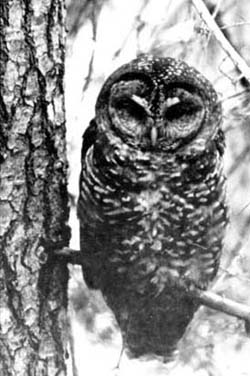Spotted Owls of Crater Lake National Park

Spotted Owl Essay from Nature Notes by Dr. Frank Lang
The spotted owl is a resident of dense coniferous and mixed evergreen forests of the western United States and northern Mexico. Ornithologists recognize three subspecies; the northern spotted owl, the California spotted owl, and the Mexican spotted owl. They have different ranges, different habits, different lives.
The spotted owl is darkish, raven-sized, dark-eyed, and without the ear- or horn-like feathers of many other owls. Other large, dark-eyed owls include its close cousin the barred owl of the east – which, by the way, is rapidly expanding its range in the northwest – and the barn owl, with its white, heart-shaped face.
Our spotted owl is the northern spotted owl. We have learned a lot about it since we realized that the owl has a definite liking for old-growth coniferous forests. Much of what we know is based on birds whose movements have been tracked by radiotelemetry. The owls are easily captured and miniature radio transmitters attached. When released, their movements can be monitored by radio receivers.
They are monogamous, mostly nocturnal, long lived and mate for life. Their home range varies from 1,800 to 9,000 acres and contains from 1,200 to 2,500 acres of old-growth. They feed, nest and roost in old-growth or old-growth trees associated with younger forests. They feed mostly on flying squirrels, woodrats, and red tree voles, nocturnal, tree-dwelling mammals whose optimum habitat is old growth.
At the present time infant mortality among northern spotted owls is worse than infant mortality among humans in the United States. more>>
From the 2005 Final General Management Plan for Crater Lake
This old- growth dependent species is at the eastern end of its range in Crater Lake National Park. There are approximately 32,260 acres of lower elevation mixed conifer forests that are considered suitable spotted owl habitat in the Park. This habitat is found in patches throughout the park, with higher density of patches and larger patch sizes southwest of a diagonal line connecting the northwest and southeast corners of the park.
All currently known nest locations have been found within areas identified as potential habitat on the west and south sides of the park, but occasional sightings have been documented outside of these areas.
The park conducts an annual monitoring program to assess the nesting and reproductive status of owl pairs living in the park. Since 1992, 17 owl pairs have been tracked. [Crater Lake National Park Final General Management Plan, Environmental Impact Statement, 2005]
Spotted Owl Survey at Crater Lake – 1992
By Lori Stonum
The northern spotted owl (Strix occidentalis caurina) is one of three subspecies of spotted owls. It is a medium-sized forest owl distinguished by its large brown eyes and mottled brown and white breast. The spotted owl is a monogamous, long-lived species, that is mostly nocturnal. Ranging from southern British Columbia to northern California, it is found on the east and west slopes of the Cascade Range and on the Olympic Peninsula. Spotted owls live mostly in low elevation coniferous old growth forests and have a limited seasonal migration.
The first recorded observation of a spotted owl at Crater Lake National Park was in 1934. Between 1934 and 1978, there were several other sightings reported. The first surveys of the spotted owl at the park were conducted in 1978 in cooperation with the Oregon Department of Fish and Wildlife and the U.S. Forest Service. Sporadic studies have been conducted since then, but a complete census was never conducted. Until 1986, studies within the park concentrated on the west side of the Cascade Range. When the surveying resumed in 1990, the southern portion of the park was included. The 1990 and 1991 surveys, however, consisted only of two-day projects with limited coverage of the park’s spotted owl habitat.
A more comprehensive survey of the northern spotted owl at Crater Lake National Park commenced in May 1992. This was the first year that a study of spotted owls in the park was conducted according to standard protocol. Survey sites were determined based on historic spotted owl sites, areas of good habitat, and the location of proposed construction within the park. Since the survey was started late in the season compared to others in the region, we concentrated on historic owl sites and future construction zones, making them our priority. New sites were added as time became available.
Overall, the number of owls found at Crater Lake in 1992 was unexpected. more>>

